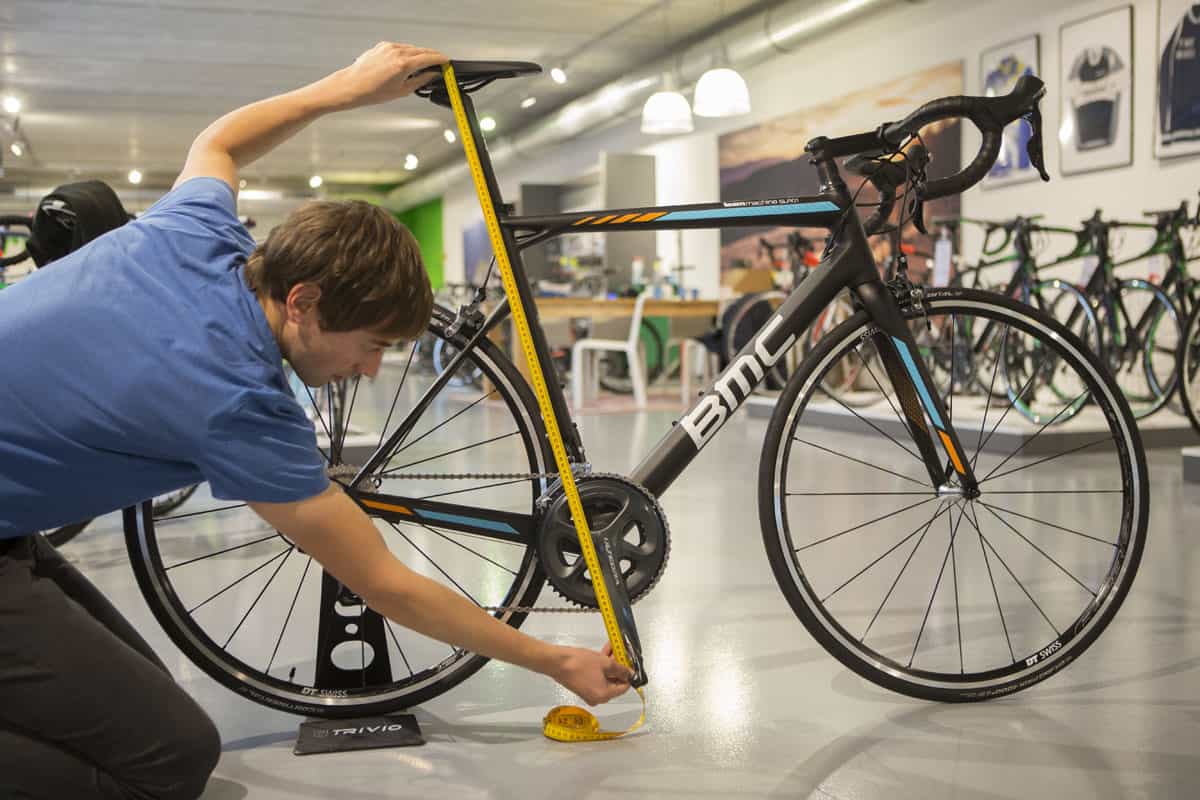
This article covers the various methods to set your saddle height. The methods are all based on averages and are a starting point to eventually dialing in your ideal saddle height.
There are many other factors to consider when setting your saddle height, such as saddle setback, saddle stack, pedal/cleat stack, shoe stack, and overall body flexibility.
The results of these methods will put you in a ballpark range. Saddle height is a very personal thing, and you’ll need to experiment for yourself to determine which one works best for you.
Heel-to-Pedal Method
The Heel-to-Pedal Method is the most common and easiest. This method involves placing your heel on the pedal.
Here’s how to do it.
- Set up your bike on a stationary trainer.
- Put on your regular cyclist clothing and cycling shoes.
- Hop on the bike and pedal for a few seconds to settle into the saddle.
- Unclip your shoes (either left or right foot) when the crankarm is at the 12 o’clock position.
- Place your heel on the pedal platform.
- Slowly pedal backward until the crankarm is at the 6 o’clock position.
- For the correct saddle height, your heel should be in contact with the pedal platform with your knee straight.
- If you need to stretch your legs for the heel to touch the pedals, then decrease the saddle height.
- If you feel that your knee is still bent, then increase the saddle height.
- Repeat several times.
Lemond Method
The Lemond Method was introduced by Greg Lemond (1986, 1989, 1990 Tour de France winner) and his coach, Cyrille Guimard, in the 1980s while he was still actively racing.
The Lemond Method involves multiplying your inseam (in millimeters) by 0.883. The saddle height is the distance measured from the center of the bottom bracket to the top of the saddle.
The calculation assumes the cycling shoes’ stack height is 15mm (in the 1980s). Most cycling shoes have a stack height between 5 to 10mm. To compensate for the reduction in the stack height, increase the saddle height accordingly.
Hamley Method
The Hamley Method (109%) is a variation of the Lemond Method.
The Hamley Method multiplies the inseam measurement by 1.09, and the saddle height is measured from the center of the pedal axle (6 o’clock position) to the top of the saddle.
Pruitt Method
The Pruitt Method was developed by Andy Pruitt, the founder of the Boulder Center for Sports Medicine in Boulder, Colorado. He is widely considered one of the leading experts in the biomechanics of cycling and played an important role in developing the Specialized Body Geometry Program.
The Pruitt Method requires setting up your bike on a bike trainer. It then uses a goniometer to measure the knee angle when the crankarm is at the 6 o’clock position. The ideal saddle height is when the knee angle is between 25º to 30º.
If the angle is above 30º, then decrease the saddle height. If the angle is below 25º, then increase the saddle height.
Professional bike fit
A bike fit is the most precise but expensive way to determine your saddle height. There are several bike fit systems today, such as Specialized BG Fit, Retul, Guru, Velogic, and Steve Hogg’s Cyclefit.
Each bike fitter uses its preferred system, and in many instances, the results may vary even if both bike fitters use the same system. This all boils down to the bike fitter’s experience and interpretation of the data.
Keep in mind that the results from the bike fit are only applicable to all the clothing and bike present during the fitting session. Change any variables (shoes, pedals, saddle, etc.), and they might affect your saddle height.
More reading : Why You Should Consider A Professional Bike Fit
Which method should you use?
Except for a professional bike fit, all the methods would work and put you in the ballpark range. It all boils down to your objective.
- For a casual cyclist, you probably don’t need to invest in a bike fit as the other methods would get you into the ballpark range.
- For serious amateur cyclists and those who had a history of injuries, it would be a good idea to get a professional bike fit.

Alex Lee is the founder and editor-at-large of Mr. Mamil. Coming from a professional engineering background, he breaks down technical cycling nuances into an easy-to-understand and digestible format here.
He has been riding road bikes actively for the past 12 years and started racing competitively in the senior category during the summer recently.